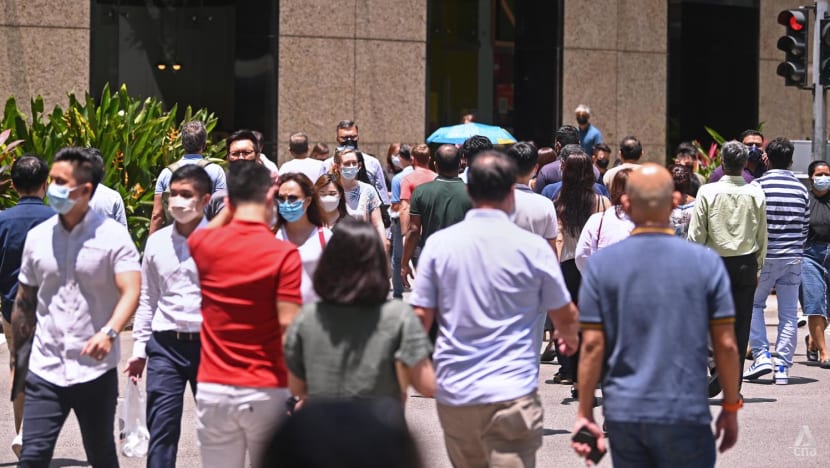Current COVID-19 wave 'will not be as severe' as earlier Omicron wave: Ong Ye Kung
Indications show Singapore is "near the peak, if not at the peak" of the current COVID-19 wave, said the Health Minister.

People wearing protective face masks in the Central Business District in Singapore on Mar 25, 2022. (Photo: CNA/Gaya Chandramohan)
SINGAPORE: The current COVID-19 wave will not be as severe as the Omicron wave earlier this year, said Minister for Health Ong Ye Kung on Tuesday (Jul 5).
Responding to a parliamentary question from MP Ang Wei Neng (PAP-West Coast) about the Government's response to the current wave of COVID-19 cases, Mr Ong said the authorities had anticipated this wave when they learnt of the BA.4 and BA.5 subvariants.
These subvariants have a "significant growth advantage" over the earlier BA.2 subvariant, he added.
“This wave, however, arrived slightly earlier than the July and August timeframe that we anticipated,” the Health Minister said.
“For this current wave, our assessment is that it will not be as severe as the Omicron wave we experienced earlier this year. This is because many more of us have gained stronger immunity, either through booster shots or recovery from infections," he added.
“This will significantly impede the circulation and transmission of the BA.4, BA.5 viruses.”
At the peak of the earlier Omicron wave, Singapore saw about 18,000 new COVID-19 cases daily.
Tuesday's COVID-19 caseload is expected to be more than 12,000, about 10 per cent more than Tuesday last week, he said, adding that Tuesday is "always the day where cases spike up".
"There are indications that we are near the peak, if not at the peak, and we should be relieved that the number this week did not double from last week. Otherwise, we'll be at 24,000 or 22,000 this week," he said.
In a supplementary question, Mr Ang asked about the percentage of recent COVID-19 infections caused by the BA.4 and BA.5 subvariants.
Of all current infections, about 50 per cent are from the BA.4 and BA.5 subvariants, said Mr Ong.
"It has been doubling every week. Started at 3 per cent, then 5 per cent, then 8 per cent, then 16 per cent, 30 per cent last week, this week 50 per cent, next week I would expect it to be 70 to 80 per cent. It is clearly a more dominant subvariant compared to BA.2."
In response to a question from MP Yip Hon Weng (PAP-Yio Chu Kang) if healthcare settings are "adequately equipped" to handle the next wave, Mr Ong said the key to managing the next wave is to ensure that Singapore’s hospital capacity is “not overly stressed”.
This includes ensuring high vaccination and booster coverage, as well as making sure healthcare institutions and facilities are prepared and ready to ramp up capacity if there are increased admissions, he added.
As of noon on Monday, there were 631 people in hospital, with 74 requiring oxygen supplementation and 14 in the intensive care unit.
“Our hospitals remain ready to ramp up dedicated ICU and isolation bed capacity should there be an increase in the number of COVID-19 patients who require hospitalisation,” said Mr Ong.
There are also “sufficient beds” in the COVID-19 treatment facilities for serious cases that do not need hospital care, he said, adding that such COVID-19 treatment facilities are about 25 per cent occupied.
The facilities were “recently consolidated” from more than 2,000 beds to about 1,300 beds, with a “higher manning ratio”, said Mr Ong. This makes it easier to transfer patients from hospitals to the facilities without a “significant drop” in levels of care, he added.
However, public hospitals continue to face “high demand” from non-COVID-19 patients, said Mr Ong.
“Over time, we hope more of our (COVID-19 treatment facilities) can be multi-purpose isolation and treatment facilities, for both COVID-19 and non-COVID-19 patients,” he added.
The COVID-19 treatment facility at Sengkang Community Hospital has been “reconfigured” to this new model, and the authorities will explore converting other facilities, said the Health Minister.
In anticipating the wave of infections, the Government maintained the indoor masking requirement even when cases were “low and stable” to “moderate the infection rate” when the new wave arrived.
“If we still want to reduce the infection rate even further, more stringent safe management measures will need to be implemented. And that means reintroducing things like group sizes, capacity limits and masking outdoors,” said Mr Ong.
"We cannot rule out these steps if we are hit with a serious infection wave, but as far as possible, we should avoid them, especially if we are reasonably confident that our hospital capacity can hold up, and that we are determined to live with COVID-19 and continue our journey of endemicity."
BOOKMARK THIS: Our comprehensive coverage of the COVID-19 pandemic and its developments
Download our app or subscribe to our Telegram channel for the latest updates on the coronavirus pandemic: https://cna.asia/telegram













